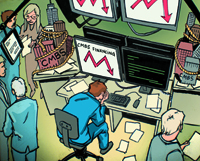Trending
CMBS shockwaves
<i>A look at the abrupt summer stall in the commercial mortgage market that could hinder New York City’s commercial real estate recovery</i>

Illustration by David ColeJuly 27 was a dark day for commercial mortgage-backed securities, or CMBS.
On that day, Goldman Sachs and Citigroup were set to begin selling a $1.5 billion batch of CMBS, secured in part by some New York City properties.
But at the last minute, Standard & Poor’s essentially put the kibosh on the deal. The rating agency said it had discovered a “glitch” in its methodology and would need more time to vouch for the worth of the mortgages at the heart of the bonds.
Without the blessing of S & P, the deal died. And with that, the CMBS market — in which pools of real estate loans are bundled together and sold to investors — hit a major snag few had anticipated when the year began.
S & P’s move — along with wild stock market fluctuations, concerns about the debt crisis in Europe and the renewed round of economic problems — helped knock the wind out of the sails of the CMBS market and confirmed the industry’s worst fears of a slowdown. Many expected the CMBS market to quadruple in value from $13 billion in 2010 to $50 billion by the end of 2011, as investors started to regain faith in the strength of the commercial real estate market. Instead, they now expect CMBS issuances to be just $30 billion this year, which calls into question reports of the market’s recovery.
When the canceled deal was announced, “in shops across the city, people were screeching,” said a source familiar with many of these “shops,” or banks, who asked to remain anonymous. Especially in the context of the broader macroeconomic meltdown, the source said, “people were hysterical.”
There was little direct effect, meanwhile, on the mortgages underlying the Goldman and Citigroup investments. The owners of those buildings had received their loans well before the mortgages were rebundled and issued as bonds.
But for the issuers, Goldman and Citigroup, the nixed deal left them vulnerable to large losses, since they were stuck with the underlying mortgages, which they’d been planning to bundle rather than holding on their books. In addition, analysts believe the daisy chain that makes up the lending market is at risk. Without the secondary market that the Goldmans of the world use to sell their loans, smaller lenders might not have deep enough pockets to, say, refinance a 16-unit apartment building on the Upper East Side.
The S & P situation could still put a damper on the larger commercial real estate market, according to Thomas Fink, the head of business development for Trepp, a CMBS-focused research firm. This is the first time, Fink noted, that he recalls a ratings agency bailing on a deal in such a way.
“The ramifications of something like [the S & P glitch] are like an engine seizing up on a motor,” said Fink, a former investment banker. “It increased the volatility in the market, and it caused concern among chief investment officers, who are now wondering if the asset class is stable.”
Looking ahead
What this sudden cooling of the CMBS market means going forward is anything but clear.
“People probably won’t tell you this, but a lot of shops have put their pens down for the rest of the year,” said an industry source.
Of course, the CMBS market is a two-way street. If potential buyers of real estate assets don’t agree to loan terms with lenders, there will be no more mortgages to sell, and the market will continue to break down. And as the economy sputters, lenders are demanding stricter repayment terms, sometimes to the point where deals don’t make any financial sense for the borrowers, said Peter Mignone, a partner in the real estate practice at the law firm SNR Denton in Manhattan.
“Lenders are not in this game to lose money,” Mignone said. So, “you’re having lots of somber conversations between lenders and borrowers saying, ‘Hey, let’s figure out something.’”
The canceled offering has shaken confidence in the industry, said one inside source, who compared it to an auto recall: “You’re a car salesman, you just sold a bunch of cars, and your supplier calls up and says, ‘We’re reviewing whether the brakes we just put on the cars are legal or not.’” The source added, “You know what kind of message that sends to the guy who has been pushing his boss to buy [CMBS]?”
Other economic realities are putting pressure on CMBS issuers too, creating new problems. For one, investors want bigger returns, since they’re committing to a security in a turbulent market, analysts said. In addition, if profit margins are thin on CMBS, banks will turn around and squeeze their vendors who are providing the mortgages in the first place to make up the profit, creating a vicious cycle, analysts said.
Mignone blames the recent market volatility not on any fundamental weaknesses in New York real estate or on the S & P loan recall — indeed, lenders continue to talk about many opportunities there, he said — but on outside, unrelated forces.
“It’s more a commentary about U.S. politics and debt problems in Europe,” he said. “It seems to be an external system shock.”
The political state he was referring to involved a weeks-long standoff between Democrats and Republicans over the country’s debt limit, exposing deep fissures and some uncertainty about the nation’s fiscal future. The drawn-out battle led S & P to downgrade the country’s AAA rating — a move that some lenders also criticized the ratings agency for. Ongoing worries about whether certain European nations like Spain and Italy can pay their bills because of their own debt woes has also made for a cloudy long-term economic outlook, which could have negative repercussions for the real estate industry.
At the same time, there are concerns that the workouts behind the loans backing CMBS need greater scrutiny. Sources said many of the special servicers who hammer out those kinds of deals, which used to be independent, are now owned by real estate companies, creating possible conflicts of interest. For instance, LNR Partners, which restructured the $1.2 billion mortgage on 666 Fifth Avenue, is now owned by Vornado Realty Trust and partners. And, Vornado recently acquired a 50 percent stake in 666 Fifth, while reducing the building’s loan balance and cutting its interest rate.
Similarly, Fortress Investment recently bought special servicer CWCapital Asset Management, and Island Capital purchased special servicer Centerline Capital.
Good times, bad times
In happier times, roughly one-third of all landlords and developers depended on CMBS bonds to finance real estate deals. The recent peak of the CMBS market was in 2007, when $243 billion in securities were issued, according to Trepp.
By 2009, however, as the office market was tanking, there were just $2 billion in new CMBS offerings.
If 2011 had posted $50 billion as expected, it would have marked a vast improvement over recent years, though it still would have only been on par with 2002, when $53 billion in CMBS were sold, according to Trepp.
Some lenders who rely on CMBS as a source of capital confirm they have lowered their expectations for the rest of the year. For example, Ladder Capital, a nationally focused, New York-based lender whose portfolio includes CVS pharmacies, will issue far fewer loans than it expected in the next four months, according to a source at the company.
Still, the CMBS market hasn’t completely dried up.
Archetype Mortgage Capital, which launched in April with the backing of the same team that bought LNR — Vornado, with Cerberus Capital Management, iStar Financial and Oaktree — said it’s staying the course. Archetype, which has $725 million in its pipeline, may not have been slammed as badly as its peers because its exposure is far more limited.
“We were lucky rather than good,” said Larry Brown, Archetype’s president, adding that he now has to charge more for his loans, because he’s being paid less for each of them. He said his margins are smaller because it’s harder to resell CMBS loans now. (Like any middlemen, the issuers take a cut of the loans they pool and sell.)
Last month, Deutsche Bank and UBS together priced a $1.4 billion CMBS offering that is backed by debt from construction loans on new New York hotels, including a pair of Fairfield Inns on West 37th and West 40th streets. Also in the portfolio is debt from the purchase of 283 East 234th Street in the Bronx, a four-story, 21-unit apartment building last listed for $2.6 million.
(A spokesperson for Deutsche Bank did not return a call for comment.)
On another front, it appears S & P has now gained confidence in its rating methods. Indeed, on Aug. 5, it announced that it could now effectively determine the value of the Goldman/Citigroup bond, which is expected to be floated again after Labor Day. S & P also said it could now rate other bonds again. But late last month, the New York Times reported that Goldman and Citigroup hired S & P competitor Moody’s Investors Service to step in and rate its sale. Critics frequently point to banks’ willingness to simply switch rating agencies until they find a rating that’s favorable.
S & P may not be out of the hot seat. In mid-August, the Justice Department announced that it was investigating the agency for possibly overvaluing mortgage securities over the years to help out its clients and pad its bottom line. And S & P’s downgrade of the country’s bond rating caused the government to accuse it of major accounting errors, leading to recriminations from political leaders.
For its part, S & P claims that it’s evolving in lockstep with a changing regulatory environment.
“Since 2008, S & P has implemented many steps to further enhance our analytics, independence and to prevent commercial interests from influencing ratings,” it said in a statement.
In the meantime, all those touched by the stalling of the CMBS market are hoping for a rebound. Without it, the billions in debt coming due on commercial real estate loans will have a hard time getting refinanced, according to David Viklund, a lawyer in the real estate practice at the firm Paul Hastings.
“The CMBS market is in the toilet. Every securitization that has come out in the last 60 days or so has priced well below expectations,” said Viklund, adding that “CMBS is needed for a full and complete real estate recovery.
“There’s just not enough money out there without CMBS, and banks can’t do this alone,” he said, adding ruefully, “There is an amazing dichotomy between now and April.”




